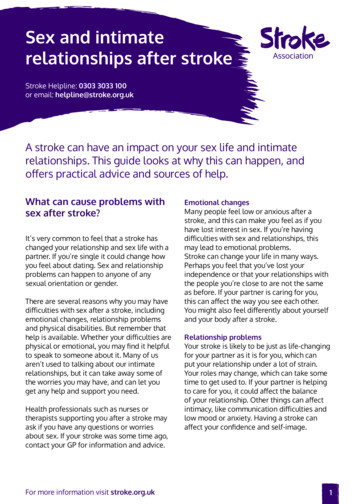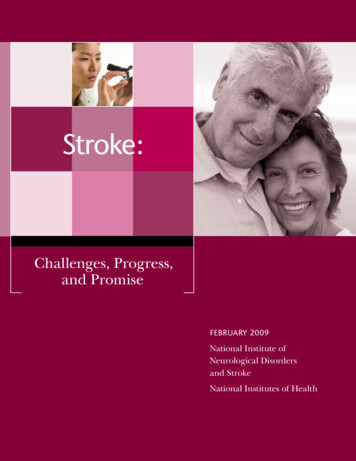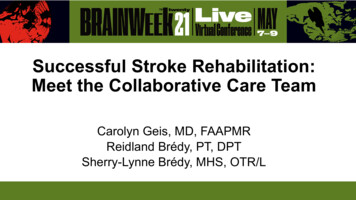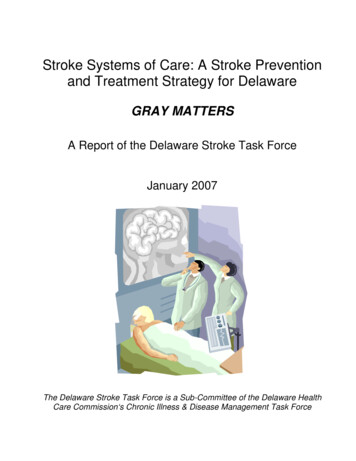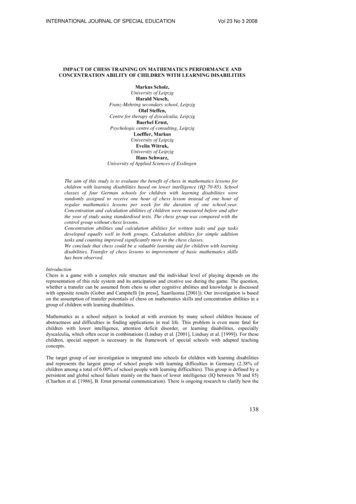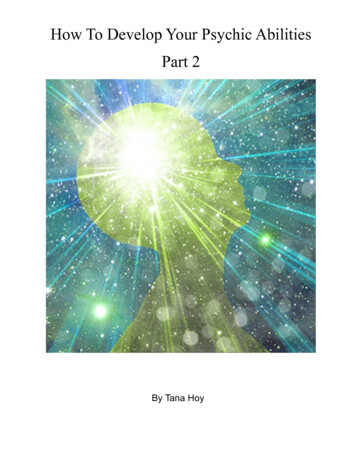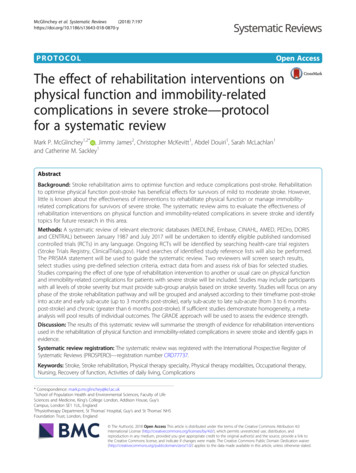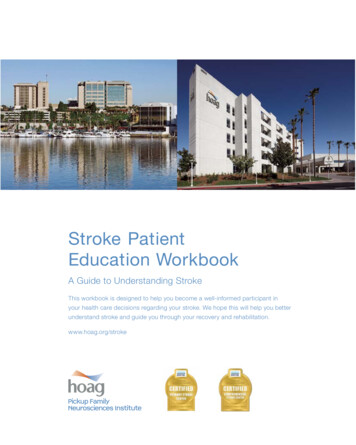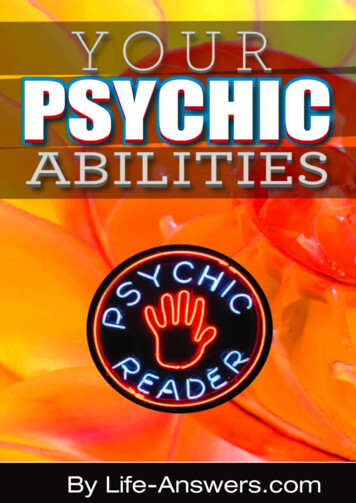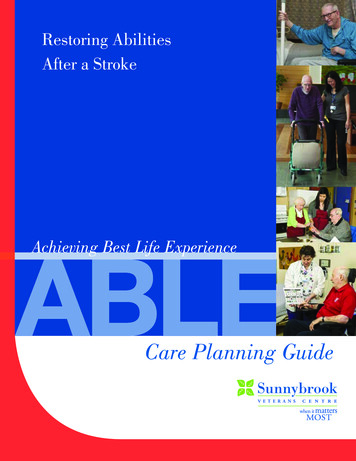
Transcription
Restoring AbilitiesAfter a StrokeAchieving Best Life ExperienceCare Planning GuideSunnybrookV E T E R A N S
Restoring Abilities After a Stroke:Achieving Best Life Experience (ABLE)Care Planning GuideVeterans Centre2012AcknowledgmentsThis Care Planning Guide was written by:Dr. Jocelyn Charles MD CCFP MScCHMedical Director, Veterans Centre, Sunnybrook Health Sciences CentreAssociate Professor, Department of Family & Community Medicine, Faculty of Medicine, University of TorontoPearl Gryfe MSc BSc OTClinical & Managing Director Assistive Technology Clinic, Sunnybrook Health Sciences CentreAdjunct Lecturer, Dept. of Occupational Science and Occupational Therapy,Faculty of Medicine, University of TorontoSelena Sun BSc PTPhysiotherapist, Veterans Centre, Sunnybrook Health Sciences CentreChris Watson MHSc SLP(C) Reg. CASLPOSpeech-Language Pathologist, Sunnybrook Health Sciences CentreKristen Paulseth MHSc SLP(C) Reg. CASLPOSpeech-Language Pathologist, Sunnybrook Health Sciences CentreCecilia Yeung RN MN GNC(C) IIWCCAdvanced Practice NurseAdjunct Lecturer, Lawrence S. Bloomberg Faculty of Nursing, University of TorontoWith the input and assistance of the K1 Centre Care TeamWe acknowledge the Heart & Stroke Foundation for sharing their educational resources referred to in this guide 2012, Sunnybrook Health Sciences Centre Veterans Centre. All rights reserved. 2012, SunnybrookHealth Sciences VeteransAll rightsRespondingto BehavioursDue Life Experience (ABLE) Care Planning GuideRestoring Abilities After a Stroke using Achieving Best Life Experience (ABLE) Care Planning Guide3
GREETINGS FROM THE VETERANS CENTRE’S DIRECTORSWe are very pleased to launch this exciting series of Achieving Best Life Experience (ABLE) CarePlanning Guides to assist our interprofessional staff, our Veteran residents and their families in workingtogether for the best possible quality of life for our residents.While traditional care focuses on achieving the best clinical outcomes using accepted scientificevidence and traditional practice methods, our ABLE philosophy focuses on planning care with theresident and family to achieve what the resident considers to be his or her best life experience inthe Veterans Centre. This involves integrating scientific evidence, the resident’s current abilities andpotential for improvement and the resident’s desired life experience. This collaborative care planningwelcomes and promotes creativity through understanding and sharing of perspectives and ideas.The ABLE Care Planning Guides are intended for use beyond Sunnybrook’s Veterans Centre. It isour hope that our ABLE guides will provide interprofessional staff working in complex continuing carefacilities and nursing homes with an easily accessible resource to use with residents and families inplanning and delivering care that is focused on what is important to each resident. We wish you asuccessful implementation!4Dorothy Ferguson, RN, BScN, MBAJocelyn Charles, MD, CCFPDirector of OperationsMedical DirectorVeterans CentreVeterans Centre 2012, Sunnybrook Health Sciences Centre Veterans Centre. All rights reserved.Restoring Abilities After a Stroke using Achieving Best Life Experience (ABLE) Care Planning Guide
TABLE OF CONTENTSINTRODUCTION 6COMPONENT 1ASSESS AND DOCUMENT ABILITIES 8COMPONENT 2IDENTIFY POTENTIAL FOR IMPROVED FUNCTION 15COMPONENT 3LISTEN TO THE VOICE OF THE RESIDENT 18COMPONENT 4CARE PLANNING TO ACHIEVE RESIDENT’S DESIRED LIFE EXPERIENCE 21COMPONENT 5INTERVENTIONS TO REDUCE ADVERSE OUTCOMES 34COMPONENT 6MONITORING THE RESIDENT’S RESPONSE TO INTERVENTIONS 47DEFINITIONS 49APPENDICESAPPENDIX 1UNDERSTANDING STROKE 52APPENDIX 2SAFE TRANSFERS 55APPENDIX 3ENSURING HYDRATION AND NUTRITION 57APPENDIX 4SUGGESTED POST-STROKE EXERCISES 60Appendix 5REFERENCES 2012, Sunnybrook Health Sciences Centre Veterans Centre. All rights reserved.Restoring Abilities After a Stroke using Achieving Best Life Experience (ABLE) Care Planning Guide635
INTRODUCTIONAt the Veterans Centre at Sunnybrook Health SciencesStroke is one of the most common causes of acquiredCentre, our goal is to help each Veteran live according todisability in the aged population and can be an overwhelming,his or her preferences and to enjoy the best life experiencelife-altering event. Approximately 20 per cent of residentspossible. While traditional best practice and clinical guidelinesin LTC have a primary diagnosis of stroke. Many of thesefocus on best clinical outcomes, in long term care (LTC) ourresidents have not had the opportunity to improve andfocus is on quality of life and helping residents perform hisrestore function. The goal of this guide is to help staff makeor her desired activities. We encourage inter-professionala difference in the lives of these residents by working withcollaboration and teamwork focused on the resident’s goals.them to restore the abilities that will allow them to achievetheir desired life experiences.Traditional stroke rehabilitation involves evidence-basedassessment and treatment by a variety of health care providersfocused on achieving the highest possible independentphysical and psychological functioning. A significant number oflong term care residents are not eligible for stroke rehabilitationprograms due to frailty, the severity of their deficits, and/orother physical and cognitive limitations. However, many canbenefit from the approach outlined in this guide, even yearsafter a stroke.This guide outlines a restorative care approach which respectseach resident’s individuality, and encourages listening to theresident’s desired outcomes, attends to the resident’s physicalcomfort and provides emotional support. Each resident hashis or her own unique values, preferences and needs. Careshould be consistent with the resident’s needs and how theresident prefers to be assisted.Written to help staff from any discipline find informationquickly and easily, this guide is a resource to help caregiversassist residents achieve their best possible quality of life andlife experience.6 2012, Sunnybrook Health Sciences Centre Veterans Centre. All rights reserved.Restoring Abilities After a Stroke using Achieving Best Life Experience (ABLE) Care Planning Guide
ABLE CARE GOAL-SETTING FRAMEWORKABLE CARE GOAL-SETTING FRAMEWORKASSESSRESIDENT’SABILITIES &NEEDSAssess verbal &nonverbalcommunicationskillsAssess cognitionAssess physicalabilities (motor,sensory, pain,cormorbid healthconditions)IDENTIFYPOTENTIAL FORIMPROVEDFUNCTION &QOL*Identify currentabilities &potential forimproved/enhancedabilitiesAssess potentialfor participationin meaningfulleisure activitiesIdentifyAssesslimitations topsychological,functionemotional & spiritualLISTEN TOTHE VOICEOF THERESIDENTShareassessmentswith resident/family- Abilities- PotentialsWhat would bethe ideal lifeexperience forthis resident inthe sh realisticgoals to achievedesired lifeexperienceHow can we helpto enable theresident toachieve goals?needs 2012, Sunnybrook Health Sciences Centre Veterans Centre. All rights reserved.Restoring Abilities After a Stroke using Achieving Best Life Experience (ABLE) Care Planning GuideCREATE &IMPLEMENTSTRATEGIESTO ACHIEVEGOALSWhat ispreventing theresident fromachieving thesegoals?Identifyinterprofessionalstrategies tofacilitateachieving lifeexperience goalsCommunicate &implementstrategiesMONITOROUTCOMESObserveresponse tointerventionsModifyinterventiosbased onresponsePeriodic reviewof abilities andgoals*QOL Quality of Life7
COMPONENT 1ASSESS AND DOCUMENT ABILITIESA stroke can affect a resident’s function in many ways. The brain controls all of our physical and mental functioning aswell as our emotions and social abilities. How a stroke impacts a resident depends on the part of the brain affected bythe stroke as well as the resident’s previous level of functioning, physical and mental health, personality, environmentand coping strategies. (See Appendix 1) Appropriate interventions through a restorative care approach1 can lead tosignificant improvements in recovery and functioning even years after a stroke.Describe Resident’s Current FunctionThe first step is to understand a resident’s current limitations to physical, psychological and cognitive functioning.Accurate recognition of functional impairments can allow for individualized restorative interventions which help reducepermanent deficits and improve a resident’s quality of life.STEP 1: Describe General AppearanceObserve and document: Level of alertness Signs of discomfort or pain Ability to speak Ability to comprehend or understand Paralysis or paresis on one side Apathy or low motivation Frustration and/or irritability Specific verbal, non-verbal and/or physical behaviours. (Refer to ABLE Care Planning Guide: Responding toBehaviours Due to Dementia.)8 Fluctuations in function or behaviours Possible barriers to functioning – communication, mobility, cognition 2012, Sunnybrook Health Sciences Centre Veterans Centre. All rights reserved.Restoring Abilities After a Stroke using Achieving Best Life Experience (ABLE) Care Planning Guide
STEP 2: Describe Ability to CommunicateDifficulties with communication may arise from a stroke affecting many different parts of the brain. In general, though, residentswho have had a stroke on the left side of the brain tend to have significant difficulties with communication. To plan appropriateinterventions to improve communication, start by to observing and documenting the resident’s current communication skills.When documenting communication, only use the term “non-communicative” when the resident has no ability to communicate,either verbally or non-verbally. Do not use nondescriptive or judgmental terms, such as “speaks funny,” “speaks nonsense”or “incomprehensible.” Also, avoid labeling; for example, “demented.”Components of Communication AssessmentAwareness of ability to Perceives communication difficulties?communicate Frustrated by communication difficulties?Ability to understand Ability to respond reliably to simple yes/no questions (eg: name, season,(comprehend)location) Ability to follow simple one-step commands, multi-step commands Ability to understand conversational speech Ability to understand more complex material (humor, information not related tothe immediate environment)Ability to express Does spontaneous speech consist of full sentences, or single words? Is spoken message on-topic? Does spoken message contain non-existent or incorrect words? Ability to name objects, people Ability to repeat single words, sentencesQuality of speech Ability to produce voice Strength or volume of voice Quality of voice (hoarse, breathy, nasal, strained) Clarity of speech (clear, or slurred) Rate and rhythm of speech (fast and rushed, slow and laborious)Written language skills Ability to write their name, letters, numbers, single words, sentences, andparagraphs Ability to read single words, sentences, or paragraphsNon-verbal language skills Level of engagement in the conversation: do they maintain eye contact, takeappropriate turns when speaking Responds to, or use facial expression to communicate? Responds to, or use gestures to communicate 2012, Sunnybrook Health Sciences Centre Veterans Centre. All rights reserved.Restoring Abilities After a Stroke using Achieving Best Life Experience (ABLE) Care Planning Guide9
COMPONENT 1continuedSTEP 3: Describe Motor AbilitiesThe ability to move after a stroke is affected by the resident’s prestroke level of functioning, the type and extent of the stroke aswell as the degree of restorative care provided after the stroke.Assessing the resident’s degree of limb and trunk mobility andfunctional mobility provides the basics for understanding limitationsto enhanced function.Describe abilitiesLimb Mobility: Is the resident able to lift his or her affected limb up against gravity? Describe effortrequired: minimal, moderate or maximal. Describe the degree of limb movement with and without assistance: passive and activerange of motion, full range or partial range for all the affected joints. Is there any pain with movement of the limbs, especially the shoulder?Functional Mobility:Ability to Roll: Is the resident able to roll from side to side independently? Describe assistance: use ofbed rail; one person assistance (minimal or moderate) or two person assistance. Is cueing needed for the affected limb?Ability to sit up at Is the resident able to get him/herself up to sit at the edge of the bed?the edge of the bed: Describe assistance needed cueing: minimal, moderate, maximal. Does he or she need to use a transfer pole or bed rail to move? Can he or she sit at the edge of the bed unsupported? With assistance? Does he or she lean to one side? How long can they sit at the edge of the bed?Ability to sit in a Can the resident sit comfortably in a manual wheelchair?manual wheelchair: Does he or she lean to one side or lean/fall forward? How long can he/she sit up in a wheelchair? Is support needed on the stroke limb when seated? Can the resident shift his/her weight or reposition him/herself independently in thewheelchair? Is the resident able to move independently in the wheelchair? Is the resident able to use a power wheelchair safely?10 2012, Sunnybrook Health Sciences Centre Veterans Centre. All rights reserved.Restoring Abilities After a Stroke using Achieving Best Life Experience (ABLE) Care Planning Guide
Describe abilitiesAbility to stand up: Describe assistance needed: minimal, moderate, maximal. Need for gait aid to stand. Describe his/her posture: are the resident’s shoulders, hips and feet aligned and parallel?Are they able to weight bear well on both legs? Can he/she stand unsupported? Describe the assistance needed for the resident toremain standing (minimal/moderate/maximal)? Is a walker/pole needed for resident to stay standing? How long can he/she stand for?Ability to walk: Can the resident weight bear well on the stroke leg or does that knee buckle? Can the resident take a normal step? How far can he/she walk? How much assistance is needed when walking: Supervision, Minimal, Moderate orMaximum? Does the resident need a gait aid when walking? i.e. walker (with wheels), rollator?Ability to Transfer: Is the resident able to follow directions safely for a safe transfer? Does the resident have good trunk control when sitting? Does the resident have good strength for weight bearing when standing? Is a transfer device needed i.e. transfer pole/walker?Limitations toMobility: What is the resident’s energy level? Appearsfatigued? Are they too drowsy? Falling asleepeasily? Are there environmental obstacles to movement? Cognition: is resident able to follow directionsfor safe mobility? Does the resident makeimpulsive movements? Strength: does resident have enough strengthfor safe mobility? Is there evidence of pain with movement:grimacing, groaning, holding a specific body area,limping, etc? Are aids/devices needed for safe transfers i.e.transfer pole, sliding board, bed rails? Are aids/devices needed for mobility: walker, wheelchair, cane? 2012, Sunnybrook Health Sciences Centre Veterans Centre. All rights reserved.Restoring Abilities After a Stroke using Achieving Best Life Experience (ABLE) Care Planning Guide11
COMPONENT 1continuedSTEP 4: Describe Perception of His or Her EnvironmentUnderstanding the perceptual challenges a resident is experiencing will enable you to identify strategies to overcome thesechallenges and help the resident achieve his or her goals. Perception encompasses how one processes and interpretsinformation from one’s surroundings. In addition to referring to the ability to see, hear, feel and taste, perception includes anawareness of time, an awareness of the location of objects in relation to each other (spatial relations), an awareness of hisor her body position in space (proprioception), and the ability to recognize familiar people, places and objects.After a stroke, a person’s ability to feel, sense temperature and be aware of his or her body position can decrease or beabsent. Following a stroke on the right side of the brain, an individual may experience neglect of his or her affected side.This individual can then unknowingly injure him or herself on the affected side. To identify neglect, you may find it useful touse the mnemonic “tune-in.”A Mnemonic to Identify Neglect12TTurning the head and/or eyes to one side and not spontaneously looking the other wayUUnaware of where an arm and/or leg is in relation to the rest of the bodyNNeglecting one side of the body, as if it doesn’t existEEvidence of repeated trauma to the affected limb, but individual is unaware of these injuriesIIgnoring food on one side of the plateNNot able to distinguish temperature (hot/cold) on the affected side 2012, Sunnybrook Health Sciences Centre Veterans Centre. All rights reserved.Restoring Abilities After a Stroke using Achieving Best Life Experience (ABLE) Care Planning Guide
STEP 5: Describe Mood and BehavioursWhen a person has a stroke, the health care team initially focuses on the physical effects of the stroke. However, theindividual may also experience fear, anger, sadness, anxiety, frustration and a sense of grief over his or her physical andmental losses. All of these emotions result in behaviour changes. Understanding some of the contributing factors to thesebehaviour changes will help you plan appropriate care strategies.The time following a stroke can be an emotional rollercoaster, with the individual experiencing a wide range of feelings – fromloss and despair, to hope, anger and resigned acceptance. In addition, a stroke can affect an individual’s ability to controlhis or her emotions, resulting in emotional lability or marked fluctuations in emotions.Residents who have suffered a stroke are at high risk for depression, which may present as cognitive decline. On admission,the clinical team should assess the resident’s prior history of depression and previous risk factors for depression. In addition,the team should assess for depression every three months. Treating this mood disorder with medication may not only relievethe depression, it may also improve mental functioning.Describe Mood and BehavioursMoods That May Indicate Depression: Apathetic or uninterested Withdrawn Sad Tearful AnxiousEmotions That May Indicate HopelessDepression: Helpless Sad Irritable Fearful Angry Suicidal thoughtsBehaviours That May Indicate WithdrawnDepression: Emotional reactions that are inappropriate for the situation A raised voice Verbal outbursts to staff, family members and/or visitors Physically aggressive towards staff, family members and/or visitors 2012, Sunnybrook Health Sciences Centre Veterans Centre. All rights reserved.Restoring Abilities After a Stroke using Achieving Best Life Experience (ABLE) Care Planning Guide13
COMPONENT 1continuedSTEP 6: Describe Cognitive FunctionThe prevalence of cognitive loss in residents whohave had a stroke is affected by many factors,including the resident’s personality and behaviourpatterns prior to the stroke, the degree of actualand self-perceived loss resulting from the stroke,the amount of social support, and the severityand location of the stroke. If the stroke involvedparts of the brain responsible for memory,learning and awareness, the residents maylose his or her ability to remember, comprehendmeaning, learn new tasks, make plans and/orengage in complex mental activities.Determining Cognitive LossesOrientation: Does the resident know where he or she is? Does the resident know what season it is? Does the resident know what year, month and day it is?Attention:Memory:Comprehension: Does the resident have a reduced ability to attend to an activity (shortened attention span)? Does the resident remember what he or she had for his or her last meal or snack? Can the resident tell you what activities he or she did today? Can the resident follow simple instructions? Can the resident engage in a conversation? Can the resident understand written information, as in signs, pamphlets? Can the resident understand the humour in a joke?Recognition: Does the resident recognize you? Does the resident recognize his or her surroundings?Further cognition assessment can include the Mini-Mental State Examination (MMSE)2 or the Montreal CognitiveAssessment (MoCA).314 2012, Sunnybrook Health Sciences Centre Veterans Centre. All rights reserved.Restoring Abilities After a Stroke using Achieving Best Life Experience (ABLE) Care Planning Guide
COMPONENT 2IDENTIFY POTENTIAL FOR IMPROVED FUNCTIONAfter assessing the resident’s level of functioning, identify the resident’s potential for improving his or her functioning andquality of life. This can be accomplished through careful observation and ongoing communication with the resident duringday-to-day activities. Look for opportunities to fulfil unmet needs, enhance function and develop potential care goals.Setting Potential Care GoalsA resident may have already achieved his or her maximum potential in some or all of the following areas of function. If thisis the case, the goal is to maintain current functioning.Potentialfor ImprovedFunctionCommunicatingIdentify Opportunities for ImprovementPotential Care Goals Appears frustrated in expressing self Enhance expressive communication Has difficulty finding words Enhance non-verbal communicationto express self Has difficulty understanding others Enhance comprehension Has difficulty understanding humour and sarcasm Has difficulty producing a voice Imprecise, unclear speech Enhance clarity of speech and/orvoice Consider input from caregiver(s) regardingcommunication habits and/or strategies 2012, Sunnybrook Health Sciences Centre Veterans Centre. All rights reserved.Restoring Abilities After a Stroke using Achieving Best Life Experience (ABLE) Care Planning Guide15
COMPONENT 2Potentialfor ImprovedFunctioncontinuedIdentify Opportunities for ImprovementRemembering, Requires frequent remindersmaking decisions Needs information to be repeatedand followinginstructions Frequently asks questions about where he or she is Appears frustrated following task instructionsPotential Care Goals Enhance ability to understand theinformation the resident desiresthrough cueing and other reminders Reduce frustration and/or anxietyrelated to poor memory Has difficulty solving day-to-day problems Enhance ability to use simplestrategies to solve day-to-dayproblems Has difficulty attending to a task – poor attention, Improve ability to attend to a taskconcentration, impulsive Has difficulty with planning and/or sequencingactivities for a particular function Enhance ability to perform desiredactivities by helping with planningand/or sequencingMoving safely Able to partially perform an activityand performing Increase participation in activities Enhance satisfaction with taskdesired tasksperformance Becomes frustrated trying to do an activity Reduce frustration Weakness limits performance of an activity Increase strength for activitytolerance Impaired fine motor control Improve fine motor control Has difficulty with mobility/transfers Enhance mobility using equipment,if needed Enhance ability to move safely Decreased ability to judge a situation and recognize Enhance judgementthe actions that are required Has difficulty with balance and/or posture16 2012, Sunnybrook Health Sciences Centre Veterans Centre. All rights reserved.Restoring Abilities After a Stroke using Achieving Best Life Experience (ABLE) Care Planning Guide
Potentialfor ImprovedFunctionIdentify Opportunities for ImprovementPerceiving Loss of awareness in the affected side (neglect)one’s self and Decreased ability to feel part of his or her bodysurroundingsPotential Care Goals Enhance recognition of self Unaware of his or her limitations Enhance recognition of abilities Unable to see part or all of surroundings Enhance appreciation ofsurroundings Limited ability to hear Optimize ability to hear Decreased recognition of people, objects and/or Enhance awareness ofthe environmentsurroundings Has difficulty appreciating the location of objectsaround him or herFeeling content Decreased awareness of time Enhance awareness of time Appears withdrawn or socially isolated Enhance mood Cries or laughs at the wrong time and cannot stop Enhance social engagement(emotional ability) Changes in personality Appears frustrated or anxious Increase contentment with dailycare activities Reduce frustration Expresses frustration and/or anxiety during dailycare activities Appears angry Decrease anger Displays aggressive behaviours (verbal and/or Reduce aggressive behaviourphysical)Participating inactivities he orshe enjoys Lethargic (lack of interest) Enhance energy level Doesn’t participate in desired leisure activities Enhance participation in the Short attention span Physical or cognitive limitations to participating inactivitiesactivities the resident enjoys Enhance ability/strength/endurancerequired to participate in desiredactivities. 2012, Sunnybrook Health Sciences Centre Veterans Centre. All rights reserved.Restoring Abilities After a Stroke using Achieving Best Life Experience (ABLE) Care Planning Guide17
COMPONENT 3LISTEN TO THE VOICE OF THE RESIDENTA basic human need is to communicate our needs, emotions and thoughts. Everything we do involves sending messagesto others.Communication deficits are among the most frightening and frustrating results of a stroke for both the resident and thecaregiver. If a stroke damages the language centre in the brain, there will be language difficulties. Some stroke residents areunable to understand or speak at all. Others seem to know what to say, but the words that come out don’t make sense.Some can no longer read or write. Many have difficulty pronouncing words.Speech, however, is only one way to communicate. We also communicate non-verbally through how we stand or move,our facial expressions, as well as the tone of our voice. As we get to know another person, we learn to read each other’sfacial expressions and body language, and communication becomes easier and more successful.Every conversation has at least two communication partners. Each partner has the responsibility to speak (to send a message)and listen (to receive and understand the message the other has sent).Strategies to Help Resident Communicate SuccessfullyBe aware that in addition to communication changes resulting from a stroke, many residents have decreased hearing and/or vision. You will need to make adjustments to accommodate these challenges.Create an Optimal Environment: Communicate in a quiet place – turn off the TV or radio, limit other distractions. Communicate face-to-face and at eye level. Ensure adequate lighting. Treat the resident with respect.Enhance Communication: Don’t rush. Speak slowly and clearly, in a natural voice. Listen carefully and actively.Monitor the Effect of Your Communication;18 Watch the resident’s facial expressions. Be aware of your non-verbal communication – facial expressions, tone of voice. 2012, Sunnybrook Health Sciences Centre Veterans Centre. All rights reserved.Restoring Abilities After a Stroke using Achieving Best Life Experience (ABLE) Care Planning Guide
Communication Do’s and Don’tsDo.Don’t.99Respect the person and his or her message.88 Dismiss the resident’s concerns.99Be supportive and offer encouragement.88 Finish the resident’s sentences without first99Try to discern what the resident is really tryingto say.99Offer positive feedback by telling the resident thathe or she is managing well.99Gently offer information and assistance to theresident to enable him or her to become moreasking for his or her permission.88 Ignore the emotion behind the message.88 Give false assurances.88 Offer unwanted advice or make assumptions.88 Be judgmental.independent.99Respond to the tone of the message if you areunable to understand the words.Empathy and respect are essential to listening and understanding. Empathy is being able to put yourself in someone else’sshoes and to be compassionate. Empathetic listening is an art that needs to be practised; it will allow you to look beyondthe words to discern what the person is really communicating.One way to show the resident you are actively listening is to match his or her mood or affect. If the resident is happy andcheerful, smile and be pleased for him or her. If the resident is sad or distressed, show concern and have a sympatheticexpression on your face.How the Past Informs the PresentUnderstanding the resident’s past can help you to identify coping strategies and opportunities for improved life experiences.Inquire About Resident’s Past: Family history, significant relationships and involvement Military service and significant past events Occupation Hobbies and interests, leisure activities Social history – desired engagement with others Specific care preferences 2012, Sunnybrook Health Sciences Centre Veterans Centre. All rights reserved.Restoring Abilities After a Stroke using Achieving Best Life Experience (ABLE) Care Planning GuideSocial history19
COMPONENT 3continuedInquire About Resident’s Current Realities: His or her life in the Veterans Centre His or her communication, cognitive and physical abilities Perception of family members Perception of staff Perception of the environment Desired activitiesResident’s perceptionQuestions to Guide a Discussion of Desired Life ExperienceEstablish the resident’s desired life experience in the Veterans Centre by asking: What is life like for you at the present time? Can you tell me about your concerns? What is most important to you? What i
Traditional stroke rehabilitation involves evidence-based . benefit from the approach outlined in this guide, even years after a stroke. . A stroke can affect a resident’s function in many ways. The bra
